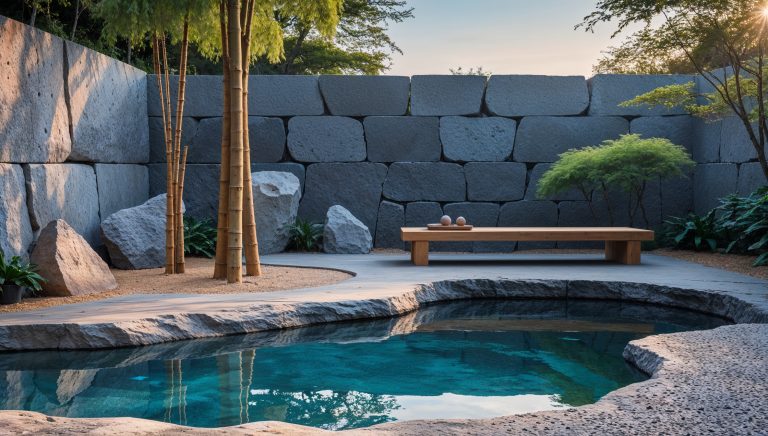A Zen garden, also known as a Japanese rock garden, is a tranquil and meditative space designed to promote relaxation and mindfulness. Originally created as a place for contemplation in Japanese temples, Zen gardens have become popular in home landscaping for their simplicity, beauty, and ability to create a peaceful atmosphere. In this article, we’ll guide you through the process of creating your own Zen garden in your backyard, from choosing the right materials to designing a space that promotes calm and serenity.
1. Understanding the Principles of a Zen Garden
Before you begin designing your Zen garden, it’s essential to understand the key principles that make these gardens unique:
- Simplicity: Zen gardens are minimalist by design, using only a few key elements to create a harmonious space. The goal is to evoke feelings of calmness and balance through simplicity, so avoid overcrowding the space with too many features.
- Balance and Harmony: The elements in a Zen garden should be arranged to create a sense of balance and harmony. The placement of rocks, gravel, and plants should feel natural, with each element complementing the others.
- Symbolism: Many Zen gardens use symbolism to represent aspects of nature, such as mountains, rivers, and waves. For example, a rock may symbolize a mountain, while raked gravel can represent water or flowing rivers. The key is to create a space that allows for personal reflection and interpretation.
- Natural Elements: Zen gardens are built around natural materials like rocks, sand, and plants. The garden should be a reflection of nature’s beauty and simplicity, with a focus on organic textures and shapes.
2. Choosing the Right Location
The location of your Zen garden is crucial to its success. It should be a quiet, peaceful area where you can relax and meditate. Here are some tips for choosing the perfect spot:
- Secluded Area: Choose a space in your backyard that is relatively secluded from the hustle and bustle of daily life. This could be a corner of your garden, near a patio, or even in a small nook.
- Flat Ground: A Zen garden works best on flat ground, as this allows for the even distribution of materials like sand or gravel. If your garden area is sloped, you may need to level the ground or build raised beds to create a flat surface.
- Privacy: If you plan to use your Zen garden for meditation or relaxation, choose a spot that offers privacy and minimal distractions. Consider using plants or fences to create a natural barrier that shields the space from view.
3. Choosing Materials for Your Zen Garden
The materials you use in your Zen garden should reflect the natural world and complement the design’s minimalist aesthetic. Here are the key elements to consider:
- Rocks: Rocks are a central feature in Zen gardens, often representing mountains or islands. Select smooth, natural stones that fit the scale of your garden. Large boulders can be used as focal points, while smaller rocks can be scattered throughout the garden to create a sense of depth.
- Gravel or Sand: Gravel or sand is typically used to create a smooth, calming surface that represents water or flowing rivers. The material should be light in color, such as white or light gray, to evoke a sense of tranquility. If you’re using sand, make sure to use a fine variety that can be easily raked into patterns.
- Plants: While a traditional Zen garden is minimalist in terms of plants, you can incorporate a few carefully chosen plants to add a sense of natural beauty and contrast. Consider adding moss, ferns, bamboo, or Japanese maple trees to provide a touch of greenery. Keep plantings sparse and avoid anything that feels too cluttered.
- Pathways: Adding stepping stones or gravel paths can enhance the sense of journey and reflection within your Zen garden. Use natural stones or pebbles to create winding paths that lead to key features like a seating area or water feature.
4. Designing Your Zen Garden
Once you’ve chosen the materials, it’s time to start designing your Zen garden. The design should be simple yet intentional, with each element carefully placed to create a harmonious and balanced space. Here are some tips for designing your Zen garden:
- Create a Focal Point: Every Zen garden needs a focal point, such as a large rock, a statue, or a small water feature. This element should draw the eye and create a sense of balance within the space.
- Rake Patterns in Sand or Gravel: The raking of sand or gravel is one of the most distinctive features of a Zen garden. Use a rake or small garden tool to create swirling, wave-like patterns in the gravel to represent the flow of water. This process can be meditative, providing a peaceful activity for maintaining the garden.
- Asymmetry: Zen gardens often embrace asymmetry to create a sense of natural balance. When placing rocks and plants, avoid perfectly symmetrical arrangements, as they may feel too rigid. Instead, focus on creating a sense of organic balance that feels natural and fluid.
- Incorporate Space: Empty space is an important element in Zen garden design. Allow areas of bare gravel or sand to provide visual breathing room, which adds to the peaceful, uncluttered atmosphere of the space.
- Consider the View: If you’re creating a Zen garden in a small area, be mindful of the view from different angles. Consider how the garden will be viewed from a seating area or nearby window and design it with that perspective in mind.
5. Adding Water Features
Water features are a common element in Zen gardens, symbolizing tranquility and the flow of life. A small water feature can enhance the calming atmosphere of your garden. Here are a few options:
- Bamboo Fountains: A traditional bamboo fountain, or shishi-odoshi, is a simple yet effective water feature for a Zen garden. The sound of water flowing in a bamboo fountain can add a soothing element to the garden.
- Small Ponds or Birdbaths: A shallow pond or birdbath can also be incorporated into your Zen garden to symbolize water. You can plant water-loving plants like lotus or water lilies in the pond or leave it simple with clear water to reflect the surroundings.
- Stone Basins: A stone basin or water bowl can serve as a tranquil focal point. You can place a small amount of water in the basin to create a reflective surface or leave it dry for a minimalist look.
6. Caring for Your Zen Garden
Maintaining a Zen garden requires minimal care, but there are a few key tasks to keep the space looking its best:
- Raking: Regularly rake the sand or gravel to maintain the patterns you’ve created. This can be a meditative task, allowing you to connect with the peaceful nature of the garden.
- Weeding: Keep the garden free of weeds, especially around the plants and rocks. Weeds can disrupt the peaceful look of the space and interfere with the flow of the design.
- Trimming Plants: Trim plants like bamboo or Japanese maples as needed to maintain their shape and keep them from becoming overgrown. Be careful not to overcrowd the garden with too many plants.
- Cleaning Water Features: If you have a water feature, be sure to clean it regularly to prevent algae buildup and ensure the water stays clear and fresh.
7. Creating a Tranquil Atmosphere
The ultimate goal of a Zen garden is to create a peaceful, meditative space where you can relax and find clarity. To enhance the tranquil atmosphere, consider adding a few elements to engage the senses:
- Seating: Incorporate a simple, comfortable seating area where you can sit and enjoy the serenity of the garden. A small bench or meditation cushion can serve as a perfect spot for contemplation.
- Lighting: Soft, ambient lighting can create a calming effect in the evening. Use subtle lights like solar-powered lanterns or low-voltage garden lights to highlight the key features of your Zen garden without overpowering the space.
- Sound: The sound of water is soothing in a Zen garden. If you don’t have a water feature, consider adding a wind chime or placing bamboo stalks in the garden that will produce a gentle sound when the wind blows.
Conclusion
Creating a Zen garden in your backyard is a beautiful and peaceful way to transform your outdoor space. By choosing the right materials, incorporating natural elements, and embracing simplicity and balance, you can create a garden that fosters relaxation and mindfulness. Whether you’re looking for a quiet space to meditate, a serene place to unwind, or a beautiful retreat to enjoy, a Zen garden offers a perfect escape from the stresses of daily life.

